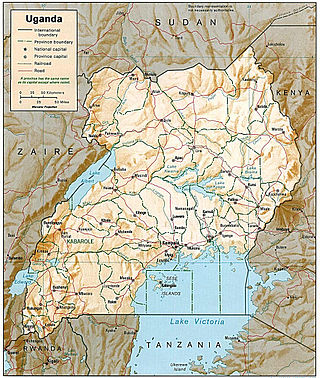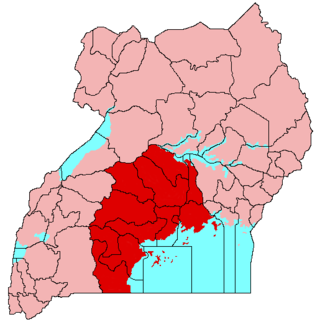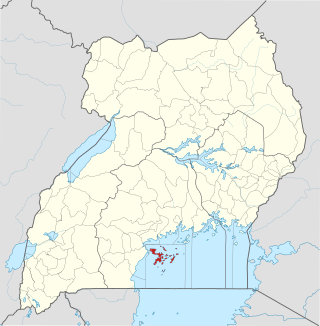
Transport in Uganda refers to the transportation structure in Uganda. The country has an extensive network of paved and unpaved roads.

Buganda is a Bantu kingdom within Uganda. The kingdom of the Baganda people, Buganda is the largest of the traditional kingdoms in present-day East Africa, consisting of Buganda's Central Region, including the Ugandan capital Kampala. The 14 million Baganda make up the largest Ugandan region, representing approximately 16% of Uganda's population.

Kalangala, also known as Ssesse, is a district in Central Uganda. The district is coterminous with the Ssese Islands in Lake Victoria and does not have territory on mainland Uganda. Like other Ugandan districts, it is named after its 'chief town', Kalangala which is located on Bugala Island, the largest of the Ssese Islands.

Mukono is one of the districts in the Central Region of Uganda. The town of Mukono is home to the district's main commercial center and district headquarters.

Wakiso District is a district in the Central Region of Uganda that partly encircles Kampala, Uganda's capital city. The town of Wakiso is the site of the district headquarters. Kira, the country's second largest city and suburb of Kampala, is in the district.
Kato Kintu Kakulukuku known in Bunyoro as Kato Kimera was the first kabaka (king) of the Kingdom of Buganda. "Kintu" is an adopted by-name, chosen for Kintu, the name of the first person on earth in Buganda mythology. Kato Kintu gave himself the name "Kintu" to associate himself with the "father of all people", and he may have renamed his wife, from Nantuttululu to Nambi, because that was Kintu's wife's name.
Bubembe Island is an island in Lake Victoria inside the country of Uganda. In the religion of the Buganda people, it is the home of the temple of Mukasa.

Kalangala is a town in Kalangala District in the Central Region of Uganda. It is the headquarters of the district.
Articles related to Uganda include:

There are two major sources of fish in Uganda; one is from aquaculture, the other from fishing in rivers and lakes. The latter has made up the largest and most significant share of all fishing. Open water covers 15.3 percent of Uganda's surface and comprises five major lakes which are the main sources of fish in the country. Lake Victoria continues to be the most important water body in Uganda both in size and contribution to the total fish catch, followed by Lake Albert and Lake Kyoga.
Bukakata, sometimes spelled as Bukakkata, is a lakeside town in Masaka District, Central Uganda.
Bugala Power Station is a 1.5 megawatts (2,000 hp) biodiesel-fired thermal power plant located on Bugala Island, in Kalangala District, in the Ssese Islands Archipelago, on Lake Victoria, in south-central Uganda.

Koome is an island in Lake Victoria, Uganda.
Bukuzindu Hybrid Solar and Thermal Power Station is a 1.6MW hybrid solar and diesel fuel-fired thermal power plant in Uganda, the third-largest economy in the East African Community.
Fishing sites and villages/communities in Uganda are mostly on islands and at landing sites. These act as central points for fish trade and fishing.
Lugonjo is a neighborhood in Entebbe Municipality, Busiro County, Wakiso District, in the Buganda Region of Uganda.
Mahathi Fuel Transport and Storage Depot is a privately-owned inland, lakeside fuel transport and storage depot in Uganda. Gasoline, kerosene, diesel-fuel and Jet A1 are delivered by ship from Kisumu, across Lake Victoria in neighboring Kenya. The fuel is stored here and conveyed by truck to final destinations in Uganda, the Democratic Republic of the Congo, Rwanda, Burundi and South Sudan, significantly cutting down delivery times and transport costs.
Lutoboka Central Forest Reserve is a protected area in Uganda's Eastern district of Kalangala. The 174 hectares Lutoboka Forest Reserve is located in Kalangala Town Council on Bugala Island.
Luggo Forest also known as LuggoCulturalForest is an heritage site and tourism Centre and home to many tree species in the Bujumba subcounty of Uganda's Kalangala district. It is a private forest found in Buswa Village along Kalangala -Mulabana Road surrounded by oil palm plantations. It is the only forest containing the tree where the mace (Ddamula) symbolizing the authority of the Katikkiro is cut from. The mace commonly known as "Ddamula" was handed over by the Kabaka to the Katikkiro symbolizing the transfer of authority to the Katikkiro to rule over Buganda on his behalf.

Kiwumulo Cave also known as Kalaya Cave is a cultural site located in Ssese islands, Kalangala district, Uganda. The cave is believed to be an origin to over 50 clans of Buganda Kingdom. The Kalaya cave is owned by Jjaja Kiwumulo or Semuggala. The cave is for the Nkima (Monkey) clan, which is one of the 52 clans in Buganda.










